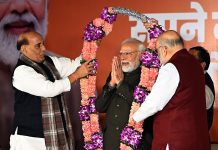 India produces over 265 million tonnes of food grains per year that can suffice to feed all its people and make farmers a happy lot! Yet, we see many go hungry and farmers are driven to commit suicide. The recent protests by farmers at Jantar Mantar grabbed national attention due to their novel, and often shocking, forms of agitation. The farmers held protest cross-dressing as women, staged street plays carrying skulls, ran naked near Prime Minister’s Office, held mouse in their mouth, conducted mock funerals, snake meat, and drank urine. The agitating farmers agreed to suspend their agitation till May 25 after getting assurance from Tamil Nadu Chief Minister E Palaniswami. During the course of their protest, the farmers met political leaders including Congress vice-president Rahul Gandhi, finance minister Arun Jaitley but the Prime Minister Narendra Modi did not meet them.
India produces over 265 million tonnes of food grains per year that can suffice to feed all its people and make farmers a happy lot! Yet, we see many go hungry and farmers are driven to commit suicide. The recent protests by farmers at Jantar Mantar grabbed national attention due to their novel, and often shocking, forms of agitation. The farmers held protest cross-dressing as women, staged street plays carrying skulls, ran naked near Prime Minister’s Office, held mouse in their mouth, conducted mock funerals, snake meat, and drank urine. The agitating farmers agreed to suspend their agitation till May 25 after getting assurance from Tamil Nadu Chief Minister E Palaniswami. During the course of their protest, the farmers met political leaders including Congress vice-president Rahul Gandhi, finance minister Arun Jaitley but the Prime Minister Narendra Modi did not meet them.
The fact is that agriculture in India has been facing many issues from fragmented land holding to depleting water-table levels, deteriorating soil quality, rising input costs to low productivity. Nearly 80 per cent of the 140 million farming families hold less than two acres of land and as land holdings are small more farmers are forced with the obsolete technology resulting in low farm incomes. Most of the farming in India is monsoon dependent and irrigation consumes more than 80 per cent of the total water use in the country. Most of the farmers are dependent on seeds sold but the spurious seeds hitting the market, farmers do not get adequate yields. Harried farmers are forced to use high amounts of fertilisers and pesticides. To add to it, the heavy dependence on traditional crops like rice and wheat points to the lack of a proper national plan on agriculture.
Eroding credit discipline
Farmers are often forced to borrow to manage expenses. Also, many small farmers not eligible for bank credit borrow at exorbitant interest rates from private sources. Farm sector indebtedness is a key reason for the many farmer suicides in the country. In such a situation, loan waivers provide some relief to farmers. However, critics of loan waivers and subsidies point out that farm-loan waivers are at best a temporary solution to ward off the issue for some time because such measures can erode credit discipline and may make banks wary of lending to farmers in the future. It also makes a sharp dent in the finances of the government that finances the write-off. However, the hard fact is that pesantary decides the fortunes of political parties, and politicians are wary of displeasing this section. For record, the gross non-performing loans in agriculture and its allied sectors surged to Rs 588 billion at the end of the December quarter, from Rs 97.4 billion in the 2007-08 fiscal year, as per the RBI data.
Indeed when Modi had announced during his poll campaign that the Centre would bear the cost of the farm loan waiver in Uttar Pradesh, it paid rich dividends to the party at the hustings. It also aroused hopes of a nationwide loan write-off but as expected it invited a backlash and lead to heart-burns in left-out states, particularly Punjab, Maharashtra, Karnataka, Tamil Nadu and Gujarat. These are the agrarian States where a significant number of farmers have been forced to commit suicide. Capt Amarinder Singh in Punjab too made a similar promise and under the “Karza-kurki khatam, fasal di poori rakam” campaign the Congress roped in some 32 lakh farmers and made them fill forms for obtaining debt relief. The Captain went beyond loans taken from banks and cooperative societies to cover those owed to arhtiyas and other commission agents.
Naturally, the question is that if big business tycoons such as Vijaya Mallya can dodge banks and industrial slowdown or recession can be a ground for writing off large industrial loans, can the persisting crisis in agriculture be overlooked? While a handful of big borrowers have created a mountain of bad loans for banks, many farmers are killing themselves over ridiculously small amounts. However, there is another question if loan waivers can be the answer for sustainable growth, which requires higher agricultural spending and productivity.
It is in such a scenario that Uttar Pradesh Chief Minister Yogi Adityanath has put other states in a piquant situation after he fulfilled BJP’s pre-election promise of a farm loan waiver providing debt relief to 21.5 million farmers. Taking their cue from Uttar Pradesh, more state governments could waive loans to farmers, to woo rural voters before further polls in the run-up to a general election in 2019. Uttar Pradesh will cover the cost of the waivers by issuing bonds.
What next?
Maharashtra and Punjab are expected to announce similar loan waivers soon. In Maharashtra, ruled by the BJP, farmers are clamouring for a bailout after two years of drought and falling commodity prices. In Punjab, known as India‘s grain bowl, the opposition Congress party won last month’s election partly on the promise of a farm loan waiver. Farmers from Tamil Nadu recently protested in New Delhi, to press their demand for drought relief and loan write-offs.
A day after Uttar Pradesh Chief Minister Yogi Adityanath’s decided to waive off farm loans worth Rs.36,359-crore, farmer leaders in Punjab were unimpressed with the decision as they said that it will hardly be any use if the Captain Amarinder Singh government would go for similar loan waiver in the state. The UP government scheme will benefit all small and marginalised farmers who took crop loans of up to Rs.1 lakh until March 31, 2016, farmer leaders said most farmers will remain outside the purview if similar scheme is brought out by the Congress government in Punjab.
The UP government scheme covers loans taken up to 31 March 2016, but farmers have taken loans twice. So what’s the use of this loan-waiver,” Bharatiya Kisan Union (BKU) chief Balbir Singh Rajewal observed. ‘We will wait for the Punjab government to waive off all farmer loans by June or we will launch an agitation for the same,” Rajewal said. “The Punjab government should waive off all type of farmer loans including the ones taken from money lenders,” he added.

The Punjab Congress manifesto had pledged waiver of debt of farmers and farm labourers. In its first meeting on March 18, the state Cabinet led by chief minister Captain Amarinder Singh decided that a group of experts would assess the agricultural debt and propose ways to end the debt in a time-bound manner. Punjab’s precarious financial position could be gauged from the fact that the State spends close to 70 per cent of its revenue generation on salaries, pensions and subsidies.
Despite financial constraints, the Punjab Government has constituted an expert group to assess the quantum of agricultural debt on farmers in Punjab and suggest way and means for its waiver. Dr T Haque, former chairman, commission for agricultural costs and prices, has been appointed chairman of the group, which has been asked to submit its report within 60 days. The two other members of the group are Dr Pramod Kumar Joshi, director (South Asia), International Food Policy Research Institute; and Dr BS Dhillon, vice-chancellor, Punjab Agricultural University, Ludhiana. The expert group would be assisted by the officers of the state government, including additional chief secretary-cum-financial commissioner (development) and principal secretary finance.
Dr Balwinder Singh Sidhu, commissioner and director, agriculture, Punjab, will be the nodal officer for the group as convener. In his capacity as convener, he will convene the meetings of the recently formed group, calling officers from the banking sector, including chief general manager, NABARD, Chandigarh and convener, State Level Bankers’ Committee, Punjab, Chandigarh. Besides assessing the total amount of credit, both institutional and non-institutional, availed by different categories of farmers, the group will work out the quantum of bad loans or debt and suggest the methodology for remission of debt. The notification points out that the group would suggest ways and means to raise resources for the debt waiver.
Punjab has a debt of Rs 1. 50 lakh crore and its population as per 2011 census was about 2.95 crores, meaning thereby that each resident of Punjab is under a debt burden of about Rs 50,000. Then close to one fifth of Punjab’s revenue is now going towards repaying the debt by way of interest and servicing. With the loan taken by farmers estimated to be between about Rs 80,000 crore, the Punjab government would have to face a bigger burden if it wants to waive off this loans. Sources said whereas loans of around Rs.9,500 crore availed by farmers from cooperative banks could be taken over by the state government, the real challenge would be dealing with loans taken from nationalized banks. Loans from national banks form 86 per cent of the total farm loans which are estimated to be close to Rs.80,000 crore in Punjab. The Chief Minister has already met the Prime Minister demanding a ‘onetime loan waiver’. But it is like Shakespearean “to be or not to be” as Centre has already rejected a similar request from Maharashtra.
letters@tehelka.com













